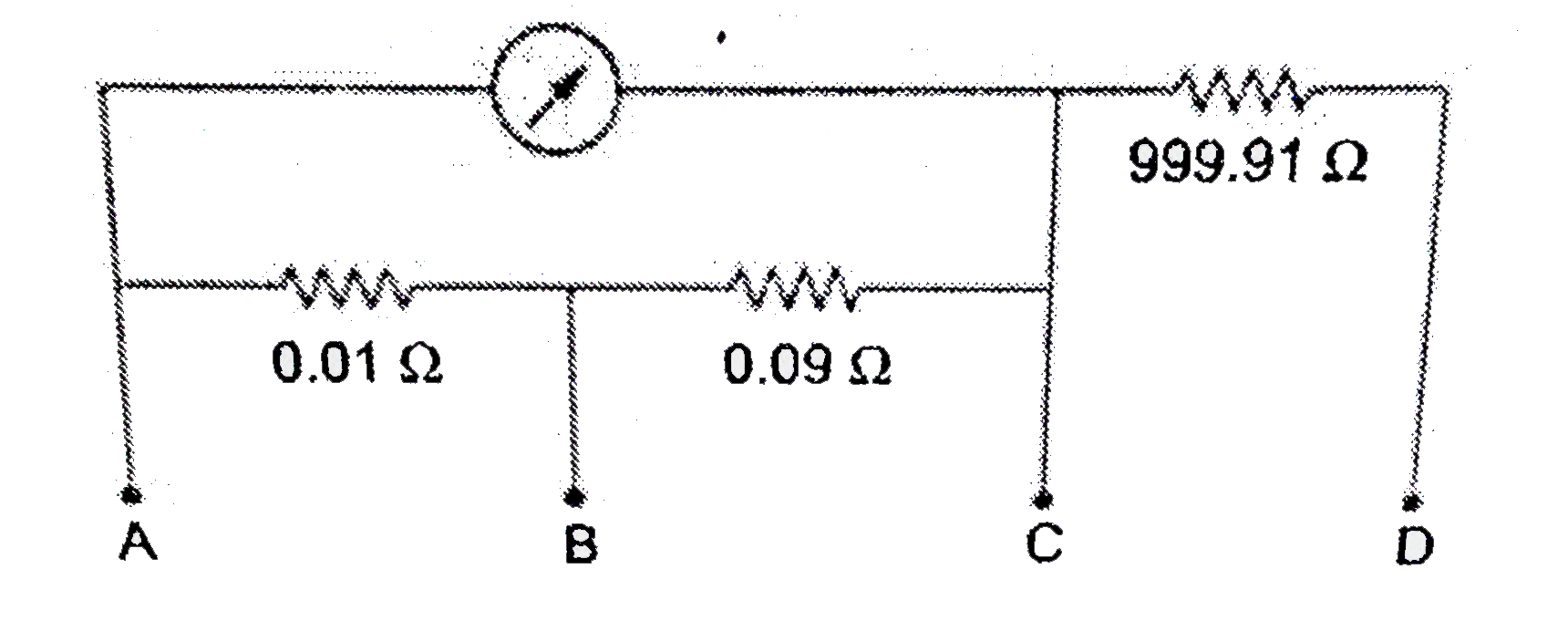Which one of the two, an ammeter or a milliammeter, has a higher resistance and why?
To determine which one of the two, an ammeter or a milliammeter, has a higher resistance, we can analyze the relationship between their designs and the shunt resistances used in each.
1. Understanding the Devices:
- An ammeter is used to measure larger currents, typically in the range of amperes.
- A milliammeter is designed to measure smaller currents, typically in the range of milliamperes (1 mA = 0.001 A).
2. Shunt Resistance Concept:
- Both ammeters and milliammeters are often based on galvanometers, which are sensitive devices that can measure small currents.
- To convert a galvanometer into an ammeter, a shunt resistance (S) is connected in parallel with the galvanometer. This allows most of the current to bypass the galvanometer, protecting it from high currents.
3. Formula for Shunt Resistance:
- The formula for calculating the shunt resistance is given by:
S=IgI−Ig
where:
- Ig is the current through the galvanometer,
- I is the total current (the range of the ammeter).
4. Comparison of Current Ranges:
- The range of current I for a milliammeter is much smaller than that for an ammeter. Therefore, for a milliammeter, I is less than for an ammeter.
5. Implication on Shunt Resistance:
- Since I is smaller for a milliammeter, the shunt resistance S for the milliammeter must be larger to allow the same Ig to be measured. This means:
Smilliammeter>Sammeter
6. Total Resistance Calculation:
- The total or equivalent resistance Req of the device can be calculated using:
Req=G⋅SG+S
where G is the resistance of the galvanometer.
7. Conclusion:
- Since the shunt resistance S for the milliammeter is greater than that for the ammeter, the equivalent resistance Req of the milliammeter will also be greater than that of the ammeter. Thus, we conclude that:
Rmilliammeter>Rammeter
Final Answer:
The milliammeter has a higher resistance than the ammeter because it requires a larger shunt resistance to measure smaller currents.
- An ammeter is used to measure larger currents, typically in the range of amperes.
- A milliammeter is designed to measure smaller currents, typically in the range of milliamperes (1 mA = 0.001 A).
- Both ammeters and milliammeters are often based on galvanometers, which are sensitive devices that can measure small currents.
- To convert a galvanometer into an ammeter, a shunt resistance (S) is connected in parallel with the galvanometer. This allows most of the current to bypass the galvanometer, protecting it from high currents.
- The formula for calculating the shunt resistance is given by:
S=IgI−Ig
where:
- Ig is the current through the galvanometer,
- I is the total current (the range of the ammeter).
- The range of current I for a milliammeter is much smaller than that for an ammeter. Therefore, for a milliammeter, I is less than for an ammeter.
- Since I is smaller for a milliammeter, the shunt resistance S for the milliammeter must be larger to allow the same Ig to be measured. This means:
Smilliammeter>Sammeter
- The total or equivalent resistance Req of the device can be calculated using:
Req=G⋅SG+S
where G is the resistance of the galvanometer.
- Since the shunt resistance S for the milliammeter is greater than that for the ammeter, the equivalent resistance Req of the milliammeter will also be greater than that of the ammeter. Thus, we conclude that:
Rmilliammeter>Rammeter
The milliammeter has a higher resistance than the ammeter because it requires a larger shunt resistance to measure smaller currents.
Topper's Solved these Questions
- BOOK - PRADEEPCHAPTER - MAGNETIC EFFECT OF CURRENT AND MAGNETISMEXERCISE - Conceptual Problems (d)2videos
MAGNETIC EFFECT OF CURRENT AND MAGNETISM
- BOOK - PRADEEPCHAPTER - MAGNETIC EFFECT OF CURRENT AND MAGNETISMEXERCISE - Very Short Answer Questions (a)2videos
MAGNETIC EFFECT OF CURRENT AND MAGNETISM
- BOOK - PRADEEPCHAPTER - ELECTROSTATICSEXERCISE - ASSERTION-REASON TYPE QUESTIONS2videos
ELECTROSTATICS
- BOOK - PRADEEPCHAPTER - OPTICSEXERCISE - Multiple choice questions1videos
OPTICS
Similar Questions
Knowledge Check
- Question 1 - Select One
If ammeter has zero resistance then –
 AReading of ammeter is ε6RBReading of ammeter is ε7RCReading of ammeter is ε8RDReading of ammeter is ε9R
AReading of ammeter is ε6RBReading of ammeter is ε7RCReading of ammeter is ε8RDReading of ammeter is ε9R - Question 2 - Select One
Statement I : If galvanometer is converted into an ammeter and milliammeter then the shunt resistance of ammeter is lower than that of milliammeter.
Statement II : The shunt resistance must allow more current to pass through in case of ammeter than that of milliammeterAIf both Statement- I and Statement- II are true, and Statement - II is the correct explanation of Statement– I.BIf both Statement - I and Statement - II are true but Statement - II is not the correct explanation of Statement – I.CIf Statement - I is true but Statement - II is false.DIf Statement - I is false but Statement - II is true. - Question 3 - Select One
Of the two bulbs , one glows brighter than the other . Which bulb has a higher resistance ?
ABrightness is independent of resistanceBThe bright bulbCBoth have the same resistanceDThe dim bulb
Out of methanoul and water which has higher viscosity and why ?
View SolutionOf the two identical galvanometers one is to be converted into an ammeter and another into a milliammeter. Which of the shunts will be of larger resistance?
View SolutionWhich one has higher diversity
View SolutionA milliammeter of range of 10mA gives full-scale deflection for a current of 100mA, when a shunt of 0.1Ω is connected in parallel to it. The coil of the milliammeter has a resistance of.
View SolutionElectrical multimeters, or multitesters, are widely used by technicians when working with electrical and electronic circuits. In this instrument, a single milliammeter connected through different resistances is used to measure currents, potential differences and resistance over different ranges.
Current always enters the multimeter at the same terminal, A, and then passes through the milliammeter as well as through other resistances, placed in series with or parallel to it. The choice of the terminal at which current leaves the instrument decides its role (ammeter, voltemeter, etc.) and its range (maximum current or voltage which it can measure).
The milliammeter shown in the circuit has a coil (or internal ) resistance of 0.9ω and gives the full-scale deflection for a current of 10mA.

If A and C are used as the terminals of the multimeter, i.e., current enters at A and leaves at C, it will function as an ammeter of rangeView Solution

